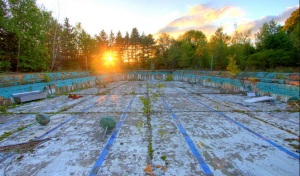Ever seen Dirty Dancing? Yeah, me neither – but it serves as one of those famous movies that represents a completely different era. In fact, Dirty Dancing was set in a Catskills resort, the same resorts that were famous during the 70’s, a sort of middle class vacation that was affordable, and in those days , booming.
However, as time has gone on we’ve seen the retreat of that ideal – most middle class workers no longer can afford vacations, and hotels are either luxuriously catering to the elite, or, well, pretty much an Econolodge made only for sleeping in an area for convenience. Now, hold on, there is a parallel here – with cities like Detroit shrinking with the fall of the industrial nation in America – there are other areas suffering from the same shift in what is being consumed and outsourced. In my hometown there’s a small hotel called Grossinger’s, now abandoned. In it’s heyday, this was one of the most famous hotel resorts in the northeast, it brought people from all over the east coast and set a precedent that was quickly followed by the rest of the Borscht Belt ( a moniker given to the resort that sprung up all over Sullivan County that catered to middle to upper middle class Jewish families).
These resorts were so popular that towns sprung up around them, enjoying the huge business that the hotels brought to the area. However, as disposable income fell and inflation rose, the typical family couldn’t afford to frequent the resorts much longer. As time went on, the decor became out of place, the number of people coming in fell and the resort, one by one went bankrupt and locked their doors. That’s all they did though, just locked the doors and walked away – making it a little too easy for urban explorers to check it out. Seeing as only 30 years have passed since Grossinger’s kicked out it’s poolside guests, to see it today is just an example of a economic interest, a service-producing industry that has fallen by the wayside.
If you see these resorts now, especially Grossinger’s, you’ll note the lovely misspelled Neonazi graffiti, and enjoy the flooded basements, the spa turned into a murky pond, and the little messages for the last guests yellowing in their cubbies. To me, it’s beautiful. However, to the generation before mine, it represents a bygone era. My father was an employee for Grossinger’s in his youth. When he was our age, he was working as a valet, in the fancy red jackets, racing Cadillacs to the edge of the parking lot for a quick dollar – it was a place that was fun, one of the best first jobs you could want. To see it today is heartbreaking. It also represents the death of our area. Once the hotel business dried up, all the money left the area. There’s no destination in Liberty, it’s a midway point that people stop by only if they have to. The income to the area has left, leaving deserted street corners, empty, broken shop windows and one or two small seedy bodega left for those who grew up in the area when it was full of business – and never left.
When the source of income leaves an area, just like in Detroit, the city quickly becomes undesirable. We see a 30% increase in crime every 3 years. Low-income housing has flooded the area – all the jobs are in the snack plant that hires illegal immigrants, and it’s hard to make ends meet. In 30 years, we have gone from a popular destination, a town that thrives, to a backwater town with nothing better to do than toss rocks at windows. It’s the change in wealth. The change in money influences the area so completely, that with a shift in interest by the public, comes a shift in living conditions for the townspeople. I have a feeling this is exactly what has happened in post-industrial America to all the towns whose source of revenue has disappeared due to outsourcing, and other factors that are natural with progression in our economy. The only thing that truly scares me is the fact that no one’s going to restore Liberty. No one’s going to pour too much more money into reestablishing Detroit. What happens when this reaches the next city as it is inevitably going to? And what if the shrinking effect doesn’t stop?








